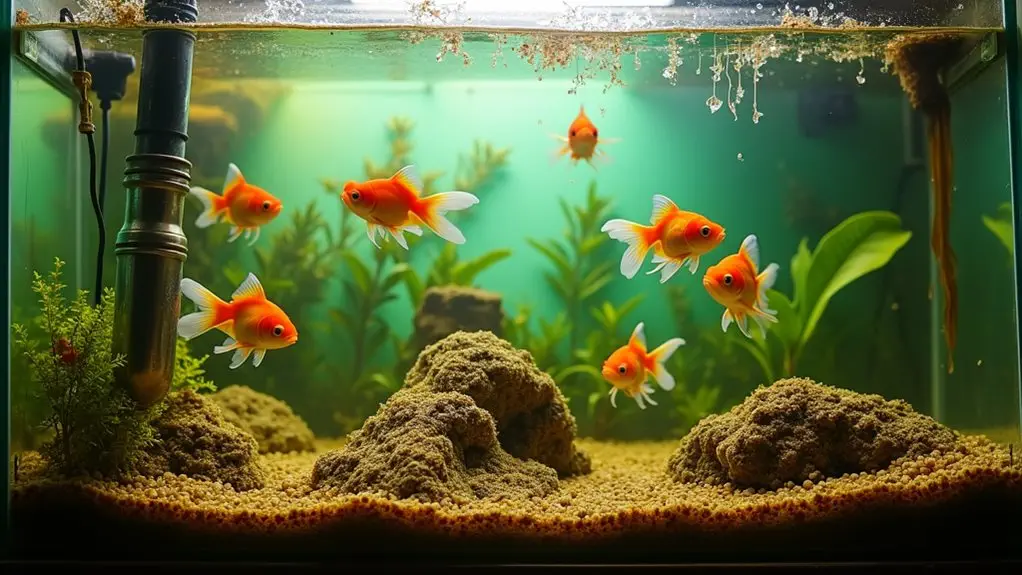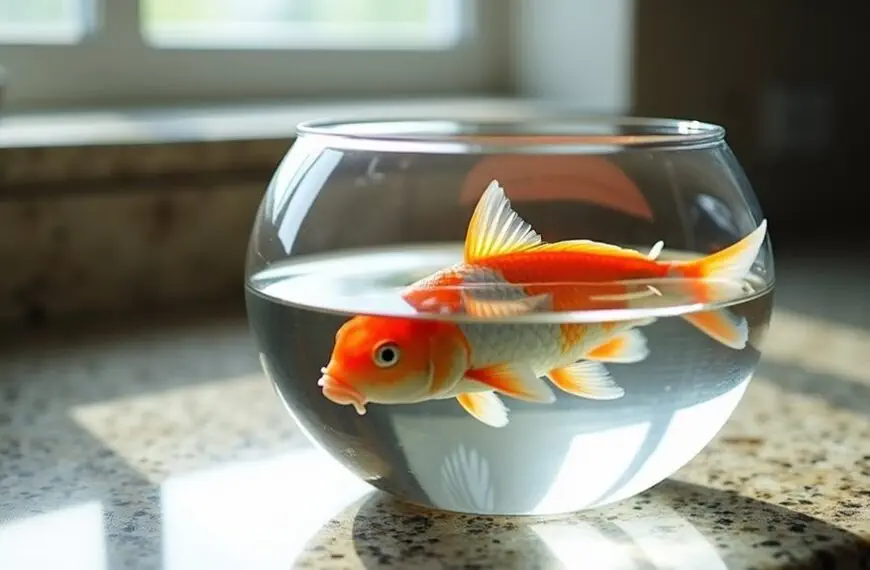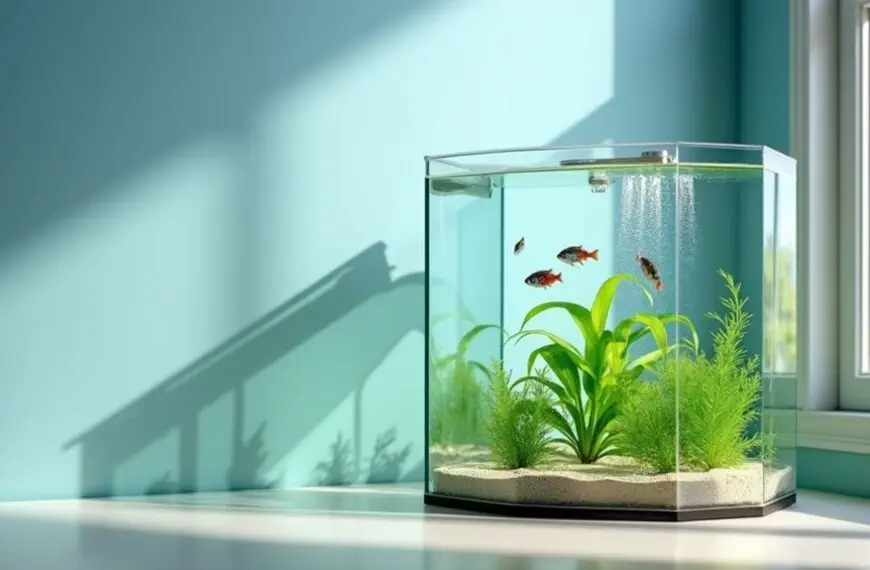Don't rush into fish tank ownership without understanding the major no-nos that could spell disaster for your aquatic friends. Never skip the essential 4-6 week cycling process, overstock your tank, or use untreated tap water. You shouldn't overfeed your fish, neglect regular water testing, or mix incompatible species that'll turn your peaceful tank into an underwater fight club. Avoid harsh cleaning chemicals, sudden large water changes, and handling fish unnecessarily. Remember to resist the temptation of smaller tanks, as they're actually harder to maintain. There's a lot more to keeping fish healthy than meets the eye.
Contents
Common Fish Tank Setup Mistakes
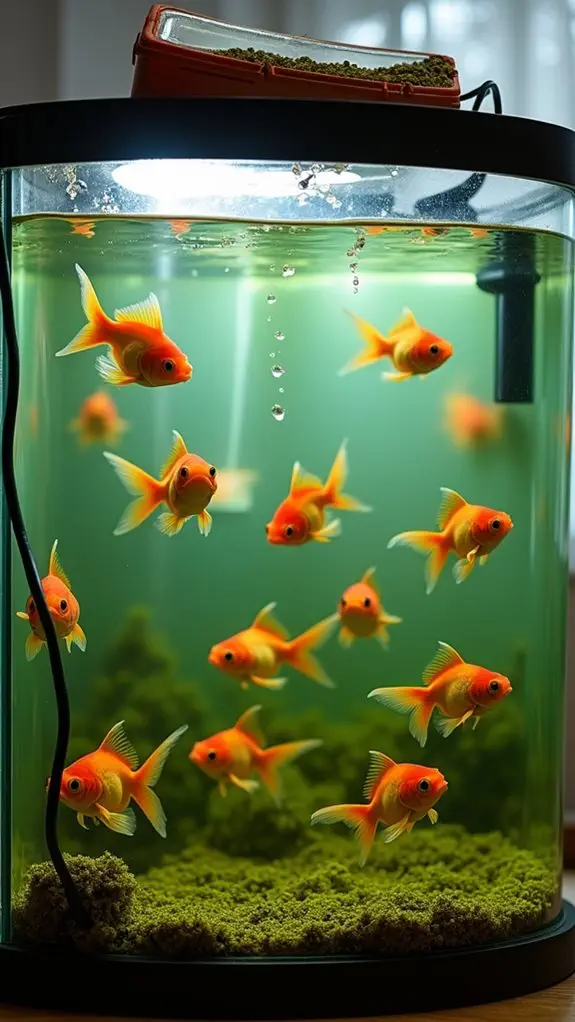
Setting up a fish tank takes more than just filling it with water and adding fish. If you're planning your first aquarium, you'll want to avoid some common mistakes that can spell trouble down the road.
First, don't underestimate the importance of tank size. While that small tank might look cute, it's actually harder to maintain stable water conditions in smaller aquariums. Your tank equipment needs to match your setup's size too – skimping on filtration systems is a recipe for disaster.
You'll want robust filtration that can handle your tank's bioload, plus proper water flow to prevent debris buildup and algae growth. Never use tap water directly when filling your tank for the first time, as it can contain harmful chemicals. Regular testing helps spot water quality issues before they become serious problems.
Watch out for materials that can mess with your water chemistry. Those pretty limestone rocks or untreated driftwood might look great, but they can throw your tank's balance out of whack, leading to unstable water parameters.
And here's a biggie that many newcomers overlook: fish size! That adorable little fish might grow into a monster that needs way more space than your tank can provide.
Take time to research adult sizes before you stock your tank, and you'll save yourself (and your fish) a lot of headaches later.
Fish Feeding Problems to Avoid
Beyond tank setup mistakes, one of the biggest threats to your aquarium's health lies in how you feed your fish. Common feeding mistakes can quickly turn your pristine tank into a troubled environment, and it's crucial to understand why less is often more when it comes to feeding your aquatic friends. Inconsistent feeding schedules can disrupt your fish's digestion. Fish like guppies and tetras thrive on a varied diet, so ensuring appropriate food types is essential.
You might think you're being kind by offering your fish extra food, but overfeeding is actually one of the most dangerous things you can do. Those uneaten flakes don't just disappear – they break down into harmful compounds that can stress your fish and promote unwanted algae growth. Different species have varied feeding habits based on their mouth location and natural behaviors.
To maintain proper nutrition balance, feed your fish small amounts several times a day rather than one large serving. Watch your fish while they eat, and only provide what they can consume within a few minutes. If you're seeing food settling at the bottom of the tank, you're definitely overfeeding.
Remember to take into account your bottom feeders too – they need specialized food, but don't go overboard. When in doubt, it's preferable to underfeed slightly than to overfeed. Your fish will thank you with better health and longer lives.
Water Quality Management Errors
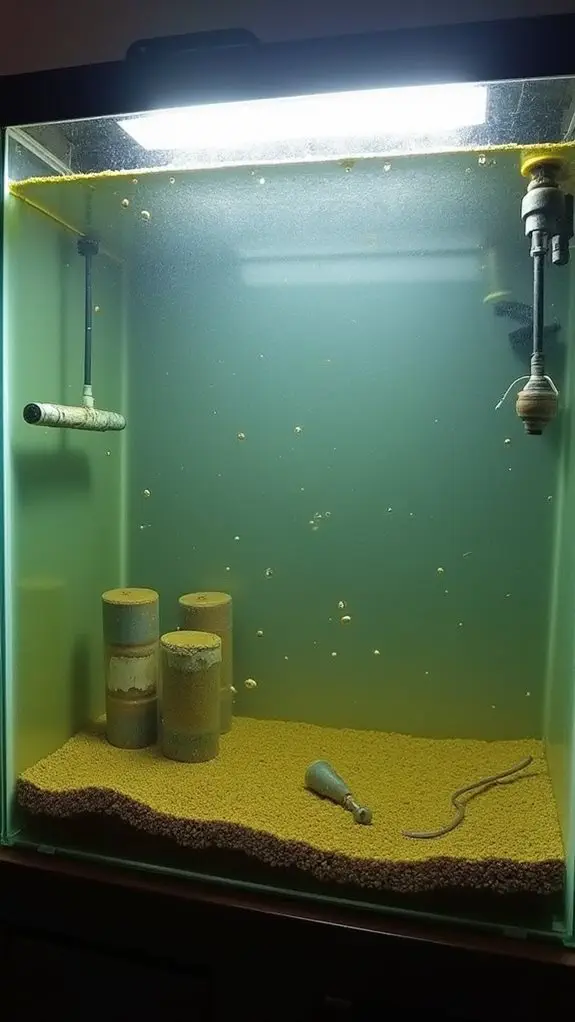
Your aquarium's water quality forms the foundation of a healthy environment for your fish, yet many owners make significant mistakes in this area. Regular water testing is essential, as it helps you catch potential problems before they become serious issues. Poor water parameters can lead to fish stress and illness.
When you're not monitoring your water parameters consistently, you might miss dangerous ammonia spikes that can harm your aquatic friends. A proper tank setup requires 4-6 weeks of cycling to establish the right bacterial balance and to ensure beneficial bacteria can effectively manage waste.
One of the biggest challenges in maintaining proper water quality is managing your filtration system effectively.
Don't make these common filtration mistakes:
- Using an underpowered filter that's too small for your tank
- Neglecting regular filter maintenance and media replacement
- Damaging beneficial bacteria with harsh chemicals
- Failing to upgrade filtration when adding more fish
Tank Maintenance Blunders
You'll risk your tank's health if you're not careful about how often you clean your filter, as skipping maintenance can lead to dangerous buildups of waste and toxins. Regular tank maintenance helps prevent fish stress and keeps your aquatic pets healthy and thriving. In addition, maintaining ideal nitrate levels is essential for fish well-being and helps reduce the chance of illness.
Be sure to rinse filter materials in old tank water rather than tap water to preserve beneficial bacteria. When it comes to water changes, you shouldn't rush to replace large amounts at once, since this can shock your fish and upset the tank's delicate balance. Instead, stick to regular, smaller water changes and gentle filter cleanings that won't disrupt your aquarium's ecosystem or stress out your finned friends. Regular water changes help maintain water quality and support fish health.
Skip Filter Cleaning Dangers
Filter maintenance negligence is one of the deadliest mistakes in fish keeping. When you skip regular filter cleaning, you're putting your aquatic friends at serious risk. Toxin buildup becomes a silent killer, and before you know it, your fish are struggling in water that's become toxic due to increased ammonia and nitrite levels. Your filter plays a vital role in providing beneficial bacteria homes that support the nitrogen cycle, which is essential for maintaining balanced water quality in your tank.
You'll want to watch out for these warning signs that your filter needs attention:
- Decreased water flow from the filter output
- Cloudy or discolored water
- Visible debris trapped in the inlet cage
- Strong, unpleasant odors from the tank
Here's the thing: you can't just rinse your filter media under tap water – that's a rookie mistake that'll kill beneficial bacteria. Instead, gently clean your filter in old tank water during water changes. Think of it as giving your filter a spa day rather than a harsh scrub-down. A consistent maintenance schedule is crucial for promoting a stable ecological balance in your aquarium.
Different filter types need different care approaches. While hang-on filters might need monthly cleaning, external filters can go longer between maintenance sessions. Maintaining a routine can significantly help avoid issues like poor water quality affecting your fish's health.
Just remember: the more fish you have in your tank, the more frequently you'll need to clean that filter. It's simple math that'll keep your fish happy and healthy.
Avoid Sudden Water Changes
Nature's delicate balance in an aquarium can be shattered by sudden, large water changes. When you're tempted to do a massive water change to "fix" your tank's problems, you're actually risking your fish's health and disrupting the tank's ecosystem.
Think of it like jumping into an ice-cold pool – that's how shocking it can be for your finned friends!
Instead of making dramatic changes, stick to smaller, more frequent water changes of 10-20% weekly. This gentle approach helps maintain stable conditions while preserving beneficial bacteria in your tank. Additionally, before performing any water change, check your (water quality parameters(#)) to understand what adjustments are necessary.
You wouldn't want to accidentally wash away these microscopic helpers that keep your aquarium healthy! Before each water change, don't forget about water parameter testing to verify everything's in check.
Fish Selection and Compatibility Issues

When you're picking fish for your tank, you'll need to think carefully about how different species will get along, as mixing the wrong ones can turn your peaceful aquarium into an underwater battleground.
Your tank's size plays a huge role in fish harmony – cramming too many fish into a small space is like putting twenty teenagers in a tiny bedroom and expecting them to stay friends.
Even typically peaceful fish can become stressed and aggressive when they don't have enough swimming space, so it's essential to match your fish population to your tank's dimensions. Ensuring a minimum tank size of 10-20 gallons is crucial for maintaining proper social dynamics and reducing stress among fish.
Avoid Mixed Species Aggression
Successful fish-keeping requires careful attention to species compatibility and aggression management. When you're planning your aquarium community, it's vital to understand fish behavior and select compatible species that'll live harmoniously together.
Don't make the rookie mistake of mixing fish with drastically different sizes or aggression levels – that's like putting a lion in with a bunch of house cats!
To maintain peace in your aquatic kingdom, follow these essential guidelines:
- Never mix highly aggressive fish with peaceful community species
- Don't keep multiple males of territorial species together
- Avoid overcrowding your tank, as it leads to increased aggression
- Start with peaceful fish first, then gradually add semi-aggressive species
Remember to create plenty of hiding spots using plants and rocks, but don't set up permanent territories that could spark fish feuds. Also, keep in mind that certain schooling fish require being kept in groups of at least six, which can help reduce stress and aggression among their species.
If you notice increased aggression, try rearranging the décor to reset established territories. It's also worth noting that captive-bred fish can sometimes be more aggressive than their wild-caught cousins, so do your homework before making purchases.
Your fish will thank you for creating a stress-free environment where they can thrive without constant bullying!
Tank Size Versus Population
Tank capacity guidelines are often misunderstood by novice aquarists who rely on outdated rules like "one inch per gallon." The truth is, proper fish stocking involves multiple factors beyond simple measurements.
When you're planning your tank's population, you'll need to evaluate the surface area for oxygen exchange, your filtration system's capabilities, and the unique needs of different fish species.
Don't forget that smaller fish actually use more energy per pound than larger ones, which affects your stocking density calculations. You're better off focusing on the total fish weight rather than just their length.
Overcrowding isn't just about space – it's a domino effect that can wreak havoc on your aquatic community. Your fish will become stressed, territorial disputes will increase, and those pristine water parameters you've worked so hard to maintain will become unstable. Additionally, maintaining optimal pH levels is crucial for ensuring your fish adapt well in a crowded environment.
Plus, all that extra waste can quickly overwhelm even the best filtration systems.
If you're noticing signs of overcrowding, don't panic! You can improve conditions by increasing water changes, upgrading your filtration, or finding new homes for some of your finned friends.
Essential Daily Care Guidelines
Proper daily care of your fish tank stands at the heart of maintaining a healthy aquatic environment. Your daily monitoring routine shouldn't feel overwhelming, but skipping it can spell trouble for your finned friends.
When you're checking on your tank each day, pay attention to your fish's behavior and make sure all equipment is running smoothly.
Here's what you absolutely shouldn't skip in your daily care routine:
- Don't forget to remove uneaten food, which can quickly pollute the water.
- Never ignore strange fish behavior or signs of stress.
- Don't skip checking water temperature and equipment function.
- Never leave water top-offs for "later" when levels are low.
You'll want to keep a close eye on fish health by watching for any unusual swimming patterns or signs of distress. It's also essential to monitor key water parameters to ensure a safe environment.
Don't handle your fish unless it's absolutely necessary, and when you do, always use a net – your hands aren't as gentle as you might think!
Frequently Asked Questions
Can I Use Soap to Clean My Fish Tank Decorations?
Don't use soap for fish tank cleaning or aquarium decoration care. It's toxic to fish and leaves harmful residues. Instead, use aquarium-safe alternatives like vinegar or hydrogen peroxide to clean your decorations safely.
Why Do My Fish Keep Swimming at the Water Surface?
Your fish's surface swimming behavior is often caused by low oxygen levels in the water. You'll need to check your tank's aeration, reduce overcrowding, and guarantee your filter's working properly to resolve this issue.
How Long Can Fish Survive During a Power Outage?
Your fish can survive 12-36 hours during a power outage, depending on tank temperature and oxygen levels. They'll last longer in larger tanks. Use manual aeration and avoid feeding to maintain water quality.
Should I Remove Sick Fish From the Main Tank?
Yes, you should remove sick fish immediately. It's an essential quarantine procedure that prevents disease spread and promotes stress reduction for both sick and healthy fish. Place them in a separate tank for treatment.
Can I Add Aquarium Salt to Every Water Change?
You shouldn't add aquarium salt with every water change. While salt has therapeutic benefits, regular use can harm freshwater fish and plants. Only use it when treating specific conditions, and maintain proper water change frequency.
Final Thoughts
You'll find that maintaining a healthy fish tank isn't rocket science, but it does require dedication and attention to detail. By avoiding these common mistakes in setup, feeding, water quality, maintenance, and fish selection, you're setting yourself up for success. Remember, your finned friends depend on you to create their perfect underwater home. Stay consistent with your care routine, and you'll enjoy a thriving aquatic ecosystem that brings joy for years to come.

